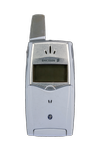




Ericsson
R520m
Announced
5 June 2000
Weight
105 grams
Codename
Madeline
Features
The R520 was included in the original Ericsson Bluetooth development kit which comprised hardware, software and the R520m as a test phone. It was the world’s first GPRS phone with Bluetooth.
At launch, Ericsson stated that the built-in Bluetooth chip “removed the requirement for cables between the phone and other mobile devices, such as PCs and handsfree devices”.
The R520 was Ericsson’s sixth WAP handset, which in conjunction with GPRS support, allowed users to send and receive data much faster than it had been previously possible when using circuit-switched data on a GSM network.
The phone was available to operators and developers for testing in the second half of 2000 and became commercially available in the first quarter of 2001.
The R520 also featured a loudspeaker providing speakerphone functionality. It included a proximity sensor that made it possible to switch from speakerphone mode to regular mode when the phone was moved towards a user's ear.
It also included voice recognition technology that could “wake up” the R520 from standby mode with a “wake word”. Once activated, owners could use voice commands to initiate calls.
There were two versions of the R520: the R520m (a prototype version is included in the Mobile Phone Museum collection) and the R520mc which had a Chinese interface that according to Ericsson was “easy to learn and easy to use”. It allowed users to send and receive Chinese SMS messages and store Chinese names in the phone book.
The “m” indicated the phone was a tri-band GSM 900/1800/1900 while “c” signified Chinese support.
It had a talk time of up to 7 hours and 35 minutes and a standby time of up to 200 hours (approximately 8 days).
Part of collection
Firsts
